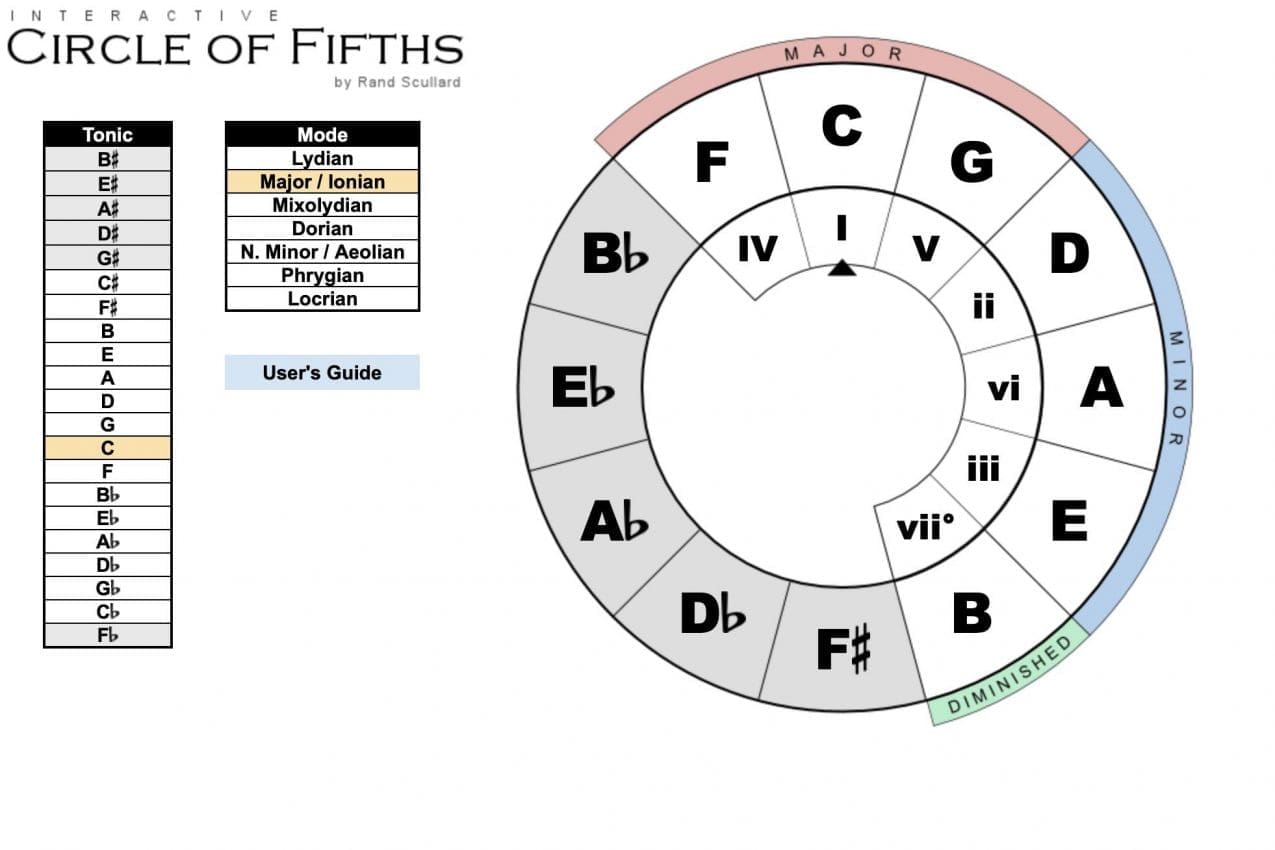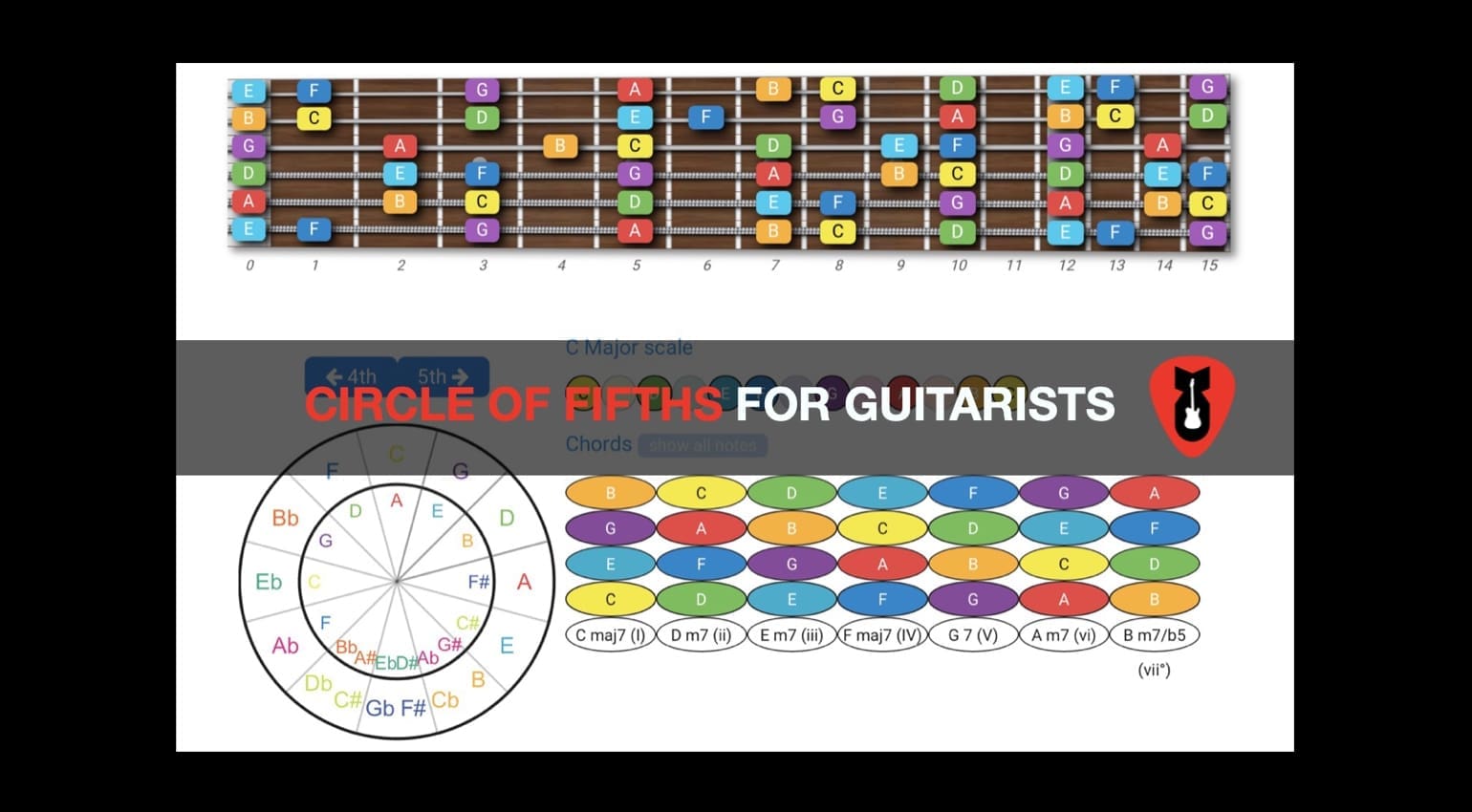The Circle of Fifths is a powerful tool for understanding music theory and its application on the fretboard, especially for guitarists. It unlocks a world of possibilities for creating compelling chord progressions and exploring different musical flavors in your songwriting.
Demystifying the Circle
This article is designed to help beginners and intermediate guitarists, or anyone who has not looked at basic music theory before, but would like to learn some useful skills for songwriting.
Imagine a circle with twelve notes, all the major and minor keys, arranged clockwise. Each adjacent note is a perfect fifth apart (think C major to G major). Here’s a breakdown:
- Moving Clockwise: Each step clockwise signifies going up a perfect fifth. (C – G – D – A – E – B – F# – etc.)
- Moving Counter-Clockwise: Conversely, moving counter-clockwise means going down a perfect fourth (the inverse of a fifth). (C – F – Bb – Eb – Ab – Db – Gb – etc.)

The Magic Lies in the Relationships
The beauty of the Circle of Fifths lies in the relationships it reveals between keys. Here’s how it applies to guitarists:
- Close Proximity = Easier Transitions: Keys closer together on the circle share more notes, making chord changes smoother. (C major and G major share many notes, making the C – G – Am progression common).
- Further Apart = More Tension: Keys further apart on the circle have fewer shared notes, creating a sense of tension or contrast when used together. (C major and Eb major are far apart, creating a dramatic shift in a C – Eb – F progression).
Applying the Circle to Songwriting
Now, let’s explore how to use the Circle of Fifths for crafting your songs:
-
Building Chord Progressions:
- The I – V – vi – IV Progression: This classic pop formula (using Roman numerals for chords) is your best friend. Look for these chords next to each other on the circle. (C – G – Am – F in the key of C major).
- Experimenting Further: Try venturing further for more adventurous progressions. (C – Am – F#m – G in the key of C major).
-
Finding Relative Minors:
- The relative minor of a major key shares the same key signature. Look directly below the major key on the circle to find its relative minor. (C major’s relative minor is Am). This creates a natural and harmonious shift.
Examples in Action:
-
Blues Inspiration: The blues heavily relies on the circle. The typical 12-bar blues progression (C – G – C – G – Am – F – C – F – C – G – C) follows the circle closely.
-
Pop Song Magic: Many pop hits utilize the circle’s principles. Maroon 5’s “She Will Be Loved” uses the I – vi – IV – V (C – Am – F – G) progression in the key of C major.
Let It Be
Let’s take a classic like “Let It Be” by The Beatles. The song primarily uses chords from the key of C major. Notice how it moves from C to G to A minor to F? That’s not random; it follows a path laid out in the Circle of Fifths.

Bonus Tip: The Circle on the Fretboard
The Circle of Fifths also translates beautifully onto the fretboard, helping you visualize chord shapes and their relationships across different positions. Resources online and in guitar books can help you map the circle onto the fretboard for a deeper understanding.
With consistent practice and exploration, the Circle of Fifths will become your secret weapon for crafting captivating chord progressions and taking your songwriting to new heights. So, grab your guitar, experiment with the circle, and unleash your musical creativity!

Useful Free Online Tools
The Circle of Fifths interactive online tool is invaluable for understanding keys and modes and is a must-have for helping to understand this part of music theory. We recommend the Circle of Fifth Interactive Guitar Tool by FaGuitar, which places this information onto the fretboard.

Further Tools for Guitarists
Read our 15 Online Tools Every Guitarist Needs article for more valuable tools for the guitar. And for new guitar players Mastering the Guitar Fretboard: A Beginner’s Guide


